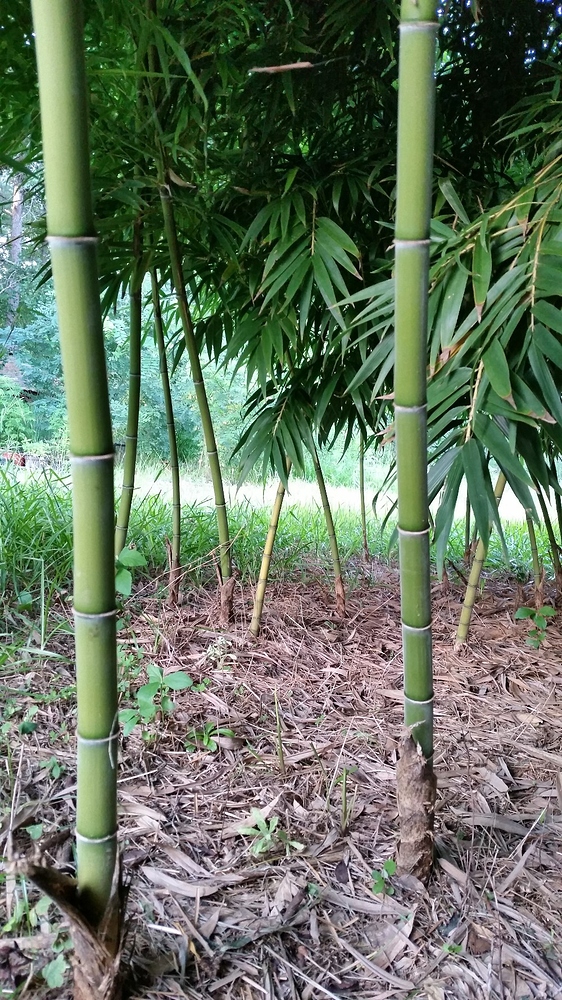Oh boy, I love talking about my bamboo! I think everyone who can should grow some form of it. It is so practical, just the culms alone have so many uses. Please excuse my spelling, I am pulling a lot of this from memory.
The main species/variants I grow are the the giant phyllostachys:
P. bambusoides (5 or so cultivars/variants)
P. dulcis
P. edulis “obviously”
P. nigra (4 or so cultivars)
P. vivax (3 cultivars)
P. viridis ‘Robert Young’
P. aurea (4 cultivars)
P. aureosulcata ‘Spectabilis’
P. glauca
P. iridescens
P. makinoi
P. bisettii
P. parvifolia (very nice cold hardy giant)
P. atrovaginata
P. flexuosa
P. I’m sure I’ve forgotten a few.
I also grow:
Pseudosasa amabilis and japonica
A few Semiarundinaria
Sinobambusa tootsik albostriata and intermedia
A few cold hardy clumpers:
Bambusa multiplex ‘silverstripe’ and ‘Alphonse Kar’
Bambusa textilis ‘Kanapha’
A few odds and ends that are still young:
Sasamorpha borealis
Indocalamus solidus
A couple of Chimonabambusa
Hibanobambusa tranquilins ‘shiroshima’
A couple of Sasaella
Indocalamus tesellatus
Shibataea kumasaca and lancifolia
I’m sure I’ve missed a few…
My groves are young, I just want them to grow at the moment. I will post pics in a sec so you can have an idea of how they perform and how long I’ve been growing them. Ultimately, my goals are:
Evergreen fodder for my ruminants (to cut down on hay costs)
Shoots for kimchi, stir fry, and other tasty goodness.
A windbreak for my orchard/collection of fruit trees.
Soil improvement for abused farmland.
Plus, I need all the culms I can get for tree stakes.
Also, shade for animals in the hot and humid South.
This is a picture in 2015 of a moso seedling. Which means it must have been germinated in 2014.
Here is a pic in July 2017 of the same moso. Notice, the foliage still retains some of the juvenile characteristics. I suspect next year these qualities will be gone.
P. viridis ‘Robert Young’ 2014.
The same P. viridis ‘Robert Young’ in 2015. Notice, no trees to the right of this pic.
The same P. viridis ‘Robert Young’ in June of 2017. BTW, there is a shorter Moso in front of the ‘Robert young’. See some trees to the right? I never planned these shots I just happened upon them in my files. The second photo is a closeup of the culms.
P. bambusoides ‘Tanakae,’ June 2017.
P. nigra ‘Punctata,’ June 2017.
Sinobambusa tootsik ‘Albostriata,’ June 2017.
As far as how big they are, it varies. My tallest is 35 or so feet, which is P. bambusoides. Thickest culms, ‘Robert Young,’ at 3ish inches. Bamboo shooting season is always impressive, but I always want more and look forward to next year.
P. bambusoides, viridis ‘Robert Young’ and rubromarginata are my quickest growers. Everyone dogs Moso as a slow grower. In zone 8 Moso seedlings exhibit seedling vigor and are very vigorous for me. The pic up top of the smaller Moso was a division. If you can’t tell, I love ‘Robert Young.’ It has a somewhat clumping growth pattern for the first few years, but still grows quickly. Most of my other runners just run in chaotic patterns. A lot of wasted energy goes into growth in areas where I don’t want bamboo.















